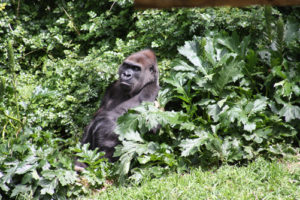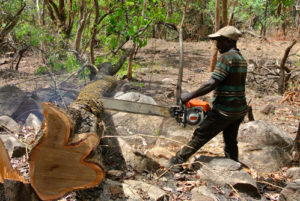Cross River Gorillas cannot be described without first discussing the major gorilla species and sub-species. There are 2 major species of gorillas – The western gorilla and the eastern gorilla. The western gorillas are divided into two sub-species – Cross River gorillas and the western lowland gorillas. The Eastern gorillas are divided into Mountain gorillas and the Eastern lowland gorillas. In this article we will be discussing about Cross River Gorillas. If you are interested in Mountain gorillas, you can check for information about mountain gorillas or facts about mountain gorillas. You can also read about Eastern lowland gorilla trekking or Kahuzi Biega National Park.
What are Cross River gorillas? Where do they live? Cross river Gorillas, also known as Gorilla gorilla diehli are subspecies of the western gorilla or Gorilla gorilla. They were first recognized as a different sub-specie in 1904 but it wasn’t until 1987 that more details about them were known. Cross River gorillas are found in the mountains, highlands and forests along the border between Cameroon and Nigeria. To be more specific, small populations are found in the Mbe Mountains in Cameroon, the Afi Mountains of Nigeria, Cross River National Park in Nigeria and Takamanda National Park in Cameroon. The closest population of western gorillas (their closest gorilla relatives) are 300 kilometers away in Cameroon’s Ebo Forest.
 Scientists like John Oates and Esteban Sarmiento believe that the Cross River gorilla started evolving into a distinct species of the western gorilla (Gorilla gorilla) during the African Pleistocene phase. This phase was characterized by aridity and little food. Some members of the western lowland gorillas were driven out because of food scarcity to the isolated forests near Cross River and the Cameroon highlands. This isolation and restrictions is arguably the leading cause of their smaller numbers.
Scientists like John Oates and Esteban Sarmiento believe that the Cross River gorilla started evolving into a distinct species of the western gorilla (Gorilla gorilla) during the African Pleistocene phase. This phase was characterized by aridity and little food. Some members of the western lowland gorillas were driven out because of food scarcity to the isolated forests near Cross River and the Cameroon highlands. This isolation and restrictions is arguably the leading cause of their smaller numbers.
Between the year 1995 and 2011, it was believed that the number of Cross River Gorillas declined by about 58%. This decline was far much more than any of the other subspecies of gorillas. In fact, it was thought that they had become extinct in the 1980’s during the civil only to be re-discovered once again. Because of their low numbers, Cross River gorillas are labeled as critically endangered by the International Union for Conservation of Nature (IUCN). Cross River gorilla are the most endangered of all Africa’s great apes – even more than the mountain gorilla. Where can you see wild Cross River Gorillas? Because of their close proximity to humans compared to their other cousins, Cross River Gorillas are shy and avoid humans. It is for this reason and also because of their low numbers that tourists cannot yet see them. They are rarely seen and gorilla tracking is not practical here.
Cross River Gorillas – Physical Characteristics and Size
Cross River gorillas differ from their nearest relatives the western lowland gorilla and the eastern gorillas mainly in terms of size. At first glance, they may look similar to the western lowland gorilla but an experienced observer will immediately notice that they have smaller skulls, ears, palates and cranial vaults. Their limbs, feet, hands and bone length is also remarkably smaller. The hair around the face is even and bare. They are without doubt the smallest of the gorilla subspecies. Adult silverback gorillas can way up to 200 kilograms.
Cross River Gorillas – Diet, Family set up, Social Life and Nesting
Like all gorilla subspecies, Cross River Gorillas are very social. They live in smaller family groups that on average contain between 4 to 7 individuals. A few groups can consist of up to 20 individuals – but this is very rare. The group is led by a dominant male silverback whose role is to protect the females and offspring. The silverback takes all decisions that has to do with the group such as feeding time and where to nest. Cross River gorilla nesting habits are influenced by factors like seasonal fruits, vegetation, the climate, presence/absence of building material and presence of predators. Most of the nests are on the ground during the dry season but during the wet season, the nests are built mainly on top of trees. Cross River Gorillas eat mostly fruits but will also chew herbs and tree bark. Most of their food is seasonal. The rainy season brings with it plenty of nutritious vegetation but the dry season ripens and sweetens the fruits. The primates therefore have a continuous flow and variety of what to feed on for now.
Habit and threats to Cross River Gorillas
Like other subspecies of gorillas, Cross River gorillas prefer to live in dense forests and highlands away from humans. Dense forests also provide all the dietary requirements they need for their large bodies. Unfortunately, with increasing human populations, forest encroachment now threatens the existence of these endangered primates. Encroachment has led to land fragmentation as parts of the forests are turned into farmland. Cross River gorillas are large creatures that require large territory to survive. As their habitats are reduced and fragmented, a particular gorilla group finds it more difficult to reach out to other groups. Although their isolation from western lowland gorillas occurred about 400 years ago as a result of natural factors, human activities are responsible for the current separation from their own. Their isolation affects the rate of gorilla reproduction leading to inbreeding and lack of gene diversity.
 Apart from forest encroachment and land fragmentation, Cross River gorillas are also threatened by hunting, exploitation of natural resources, wood harvesting/logging and clearing of land for farming. Hunting of Cross River Gorillas has also been a problem. This hunting occurs mostly in the lowlands and is one of the reasons why most of the larger gorilla groups thrive in the highlands. Hunting is mostly for meat which is consumed locally or sold to countries nearby. Even though hunting of wild gorillas has become very rare these days, poaching for other wild creatures living in the same area as the gorillas is still a great threat. Poachers leave behind wire snares which can be very harmful to the primates. There are also cases where individuals are hunted for their bones which are then used for traditional medicine (local witch doctors). Other threats to Cross River gorillas include animal traffickers and Ebola.
Apart from forest encroachment and land fragmentation, Cross River gorillas are also threatened by hunting, exploitation of natural resources, wood harvesting/logging and clearing of land for farming. Hunting of Cross River Gorillas has also been a problem. This hunting occurs mostly in the lowlands and is one of the reasons why most of the larger gorilla groups thrive in the highlands. Hunting is mostly for meat which is consumed locally or sold to countries nearby. Even though hunting of wild gorillas has become very rare these days, poaching for other wild creatures living in the same area as the gorillas is still a great threat. Poachers leave behind wire snares which can be very harmful to the primates. There are also cases where individuals are hunted for their bones which are then used for traditional medicine (local witch doctors). Other threats to Cross River gorillas include animal traffickers and Ebola.
Regarding behavior and aggression, Cross River Gorillas have been found to throw long grass, sticks and mud to scare off humans. This is an unusual behavior which is not seen with other subspecies of gorillas. Wild gorillas usually move away when they encounter humans and only charge if they are clearly threatened. This more aggressive behavior from Cross River Gorillas is attributed to the constant contact with humans in the farms and fields surrounding the highlands.
Conservation of Cross River Gorillas
 As already discussed earlier, the greatest threat to Cross River Gorillas is habitat loss. Considering that only about 300 remain in the wild, the death of just one individual for whatever reason is very significant. The good news is that even without gorilla tourism, the endangered status of the primates has attracted a lot of attention from the local governments and several wildlife conservation organizations. As part of Cross River Gorilla conservation efforts in the region, the Takamanda National Park and Kagwene Gorilla Sanctuary was created by the government of Cameroon. These two wildlife conservation areas combine with Cross River National Park in Nigeria to form a wider conservation region and zone offering more space for the primates to move between borders.
As already discussed earlier, the greatest threat to Cross River Gorillas is habitat loss. Considering that only about 300 remain in the wild, the death of just one individual for whatever reason is very significant. The good news is that even without gorilla tourism, the endangered status of the primates has attracted a lot of attention from the local governments and several wildlife conservation organizations. As part of Cross River Gorilla conservation efforts in the region, the Takamanda National Park and Kagwene Gorilla Sanctuary was created by the government of Cameroon. These two wildlife conservation areas combine with Cross River National Park in Nigeria to form a wider conservation region and zone offering more space for the primates to move between borders.
The government in Cameroon and Nigeria have also enforced stringent wildlife laws within the national parks and especially the Kagwene Gorilla Sanctuary in an attempt to protect the primates. A planned highway through the Ekuri community forest was diverted to avoid interference with the last remaining habitats of the primates. To enforce wildlife laws and maintain the boundaries in the sanctuaries, forests and national parks where Cross River gorillas are found, the governments have deployed guards to ensure that there are no human encroachments on gazetted areas. Hunting of gorillas has been outlawed.
The two governments have also partnered with various international conservation Agencies including the IUCN, Wild World Fund for Nature (WWF) and Wildlife Conservation Society (WCS). The IUCN and WCS were very instrumental in the creation of the Kagwene Gorilla Sanctuary. They helped fund the creation of protected areas while also supporting the enforcement of laws within the national parks and  sanctuaries. For any conservation efforts to be effective and successful, the communities living near the wildlife have to be involved. To that end, WCS has funded projects which help enhance the capacities of local communities to thrive without encroaching on forests. Communities living close to the gorilla reserves and parks have been supported to find alternative livelihoods. They have also funded projects that help raise awareness about the importance of wildlife conservation and protecting the gorillas for posterity. WWF has also helped with resources for creating ranger posts, recruiting anti-poaching personnel and acquiring communication devices. WWF has even gone ahead to work with logging companies with the purpose of protecting important wildlife waterways and corridors.
sanctuaries. For any conservation efforts to be effective and successful, the communities living near the wildlife have to be involved. To that end, WCS has funded projects which help enhance the capacities of local communities to thrive without encroaching on forests. Communities living close to the gorilla reserves and parks have been supported to find alternative livelihoods. They have also funded projects that help raise awareness about the importance of wildlife conservation and protecting the gorillas for posterity. WWF has also helped with resources for creating ranger posts, recruiting anti-poaching personnel and acquiring communication devices. WWF has even gone ahead to work with logging companies with the purpose of protecting important wildlife waterways and corridors.
